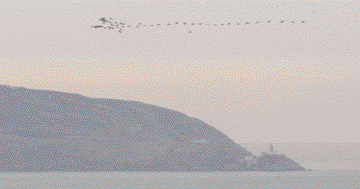| Dalkey Tidy Towns |
  |
| Dalkey Tidy Towns |
  |
|
Wildlife
Newsletter for the Township of Dalkey March 2011 - Michael Ryan |
 Brent Geese Photo: M. Ryan |
|
|
| In the past we’ve waited for them at Colimore Harbour or Sorrento Point as the light starts to fade. Sometimes, for instance if they’re flying into a northerly wind, they’ll fly close to the land in Killiney Bay then rise directly over Dalkey Hill, but most of the time they’ll follow the coast passing a few feet above the sea at Dalkey Sound. Sometimes we’ve almost given up on them when suddenly honking calls come out of the gloom and flights of geese fill the sky as they soar overhead, flying north into the last fading light of the sinking sun. Going from Dublin to Wicklow and back to feed may seem a long way to travel every day but these are birds which, when in April their body clocks will tell them to fly north, will fly directly to Iceland in one unbroken flight for their first stop over. They will then feed up in Iceland putting on another 40% of body weight before setting off on the last lap of their long journey to their breeding grounds in Arctic Canada. Although a relatively small bird they have the longest migration distance of any species of goose. |
| In the past we’ve waited for them at Colimore Harbour or Sorrento Point as the light starts to fade. Sometimes, for instance if they’re flying into a northerly wind, they’ll fly close to the land in Killiney Bay then rise directly over Dalkey Hill, but most of the time they’ll follow the coast passing a few feet above the sea at Dalkey Sound. Sometimes we’ve almost given up on them when suddenly honking calls come out of the gloom and flights of geese fill the sky as they soar overhead, flying north into the last fading light of the sinking sun. Going from Dublin to Wicklow and back to feed may seem a long way to travel every day but these are birds which, when in April their body clocks will tell them to fly north, will fly directly to Iceland in one unbroken flight for their first stop over. They will then feed up in Iceland putting on another 40% of body weight before setting off on the last lap of their long journey to their breeding grounds in Arctic Canada. Although a relatively small bird they have the longest migration distance of any species of goose. |
 Brent
Geese Flying North Brent
Geese Flying NorthPhoto: M. Ryan |
|
WHEATEAR |
 Wheatear on Killiney Hill, Spring 2010 Photo: Lucy Desierdo |
| Sad report of a red squirrel found dead on the road, probably ran over by a car, in mid January. The squirrel was found at Oakdene just off Ballinclea Heights. There were reports last year of red squirrels being seen on telegraph lines around Ballinclea heights and since these observations were made in spring and summer it’s possible the reds may have built a drey and possibly bred in a tree in someone’s garden. Young adult squirrels have to move way from their parents to set up new territory and it’s often while they’re on the move trying to cross roads that they meet unfortunate ends. In a number of places in Britain where endangered red squirrels had high numbers of fatalities crossing roads, rope bridges were suspended above the roads, baited with acorns and other food to attract squirrels to them. Subsequent studies found the ropes provided were used by the squirrels when positioned properly. Cars and cats are the main cause of unnatural death in red squirrels. |